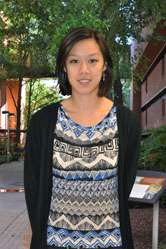Media and Communications
“A New Direction for Chinese Society: Chinese Millennial Engagement with Art and Social Media”

For the Post-1980s generation of Chinese youth Cultural Revolution is no longer part of their personal historical memory, whereas, for previous generations of Chinese of the post 1945 era, the Cultural Revolution was a defining moment. The Chinese Millennials, as they are referred to in the media, those who are currently between the ages of 18 and 30, struggle with finding their identity while feeling separated from the historical trajectory of the Chinese people. This generation must contend other societal demands as well, most notably, China’s One-Child Policy, which has shaped a very isolated, pressured, and introspective environment for young individuals. I wish to gain insight on how urban young adults in China today engage in various forms of media practices (specifically art and social media) to reflect on their unique upbringing in a rapidly changing and globalizing society. I plan to travel to China to study the Chinese Millennials’ engagement with artistic practices and social media with the intention of developing an understanding of the stimulus behind the artistic energy of a social group who is considered the product and agent of social change. By engaging with young Chinese peers on a local level and then adding to my preliminary study of Contemporary Chinese art by interviewing up-incoming artists and experiencing their artwork first-hand, I will be able to generate a socio-historical analysis of their creative practices and place them within the context of a globalizing world atmosphere.
How did you find your mentor for your research project?
Professor Fan Yang was my professor for MCS222: Intro to Media & Comm. Studies. During the class, she described her personal research involving Apple products in the Chinese youth community. Eventually, after I narrowed down what I wanted to research, I knew that Professor Yang was the perfect candidate to be my faculty advisor.
How did you know this was the project you wanted to do?
It took months and semesters to really refine the topic I wanted to research. A culmination of academic studies, personal motivation and faculty guidance helped me to realize my project proposal.
Is this your first independent research project?
Yes.
Do you get course credit for this work?
No.
How much time do you put into it?
So far, for my preliminary studies, I cannot come up with a concrete number as to how much time I have put into it. I am always thinking about it, when I am researching other topics for classes, when I am planning my travel activities, and especially when I am brainstorming ideas for my next proposal. (Fulbright)
How did you hear about the URA program?
I heard about it first from Professor Preminda Jacob. She has served on the URA committee and she recommended that I try for one. She is one of the art history professors who I am very close to and talk to about my future academic and professional goals.
What academic background did you have before you applied for the URA?
As far as research background, I have taken a handful of art history courses that require us to write independently researched papers. In the fall of 2012, Professor Smalls’ Non-Western Art seminar has further guided my research topic towards Contemporary Chinese Art. Most recently I’ve had the opportunity to shape the research for my Art History Capstone Thesis paper as mostly a preliminary study of the global perspective on Contemporary Chinese Art.
Was the application difficult to do?
Yes, the process was time-consuming and tedious, but a worthwhile process to go through, especially in the arts field where proposals are crucial.
How much did your mentor help you with the application?
My mentor was really helpful by being there to bounce ideas back and forth. She really helped me articulate my ideas sophisticatedly and intellectually, especially when she took the time to proofread my drafts.
What has been the hardest part about your research?
The hardest part about my research has been working around the limitations of sources that are based in a western perspective. It has been hard deciphering what is true to the group of people I am studying because the topic is novel and has not been written about academically to a large extent.
What was the most unexpected thing?
The most unexpected thing is how much my topic ideas changed throughout the application drafting process. As I learned different things in my preliminary study, it change. As I articulated statements differently, it changed. As I discussed with my faculty advisor(s), it changed.
How does your research relate to your work in other classes?
The theories and concepts that apply in my art history and media and communication studies classes have helped me to approach my topic in structured frameworks. They have helped me to focus my topic and to find a starting point.
What else are you involved in on campus?
I am a member of the Women’s Varsity Volleyball team and I also coach the Men’s Club Volleyball team. I am a research assistant to Professor Preminda Jacob (Art History) in her research of street murals in the city of Chennai, India, and Professor Jason Loviglio (MCS) in his research of postliberalism in NPR.
What is your advice to other students getting involved in research?
Be creative and stay open-minded and flexible when it comes to topics. But also, be specific, especially in the Humanities.
What are your career goals?
In the long run, I want to be involved in the arts world in an influential position. I aim to get into arts administration or arts education in order to help artists and creative minds make a difference in our culture.
Did you transfer?
No.
7/17/2013